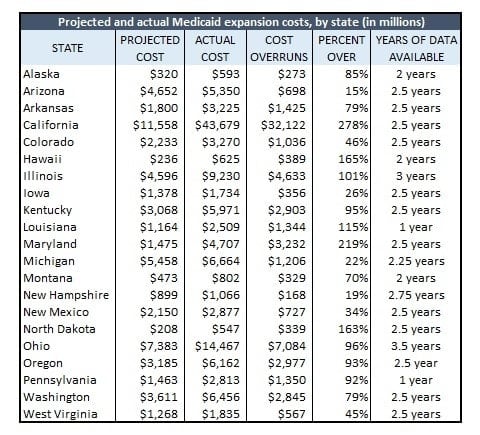The Impact of Medicaid Expansion on State Budgets
Many states that have expanded Medicaid under the Affordable Care Act (ACA), or “Obamacare,” have experienced unforeseen cost increases due to unexpected enrollment increases, as well as higher per person costs. This has led to concerning increases in the percentage of state budgets taken up by state-level Medicaid spending.
The Kansas Policy Institute noted the findings of a 2018 report from the Foundation for Government Accountability on the costs of state Medicaid expansion:
- States that expanded Medicaid under the ACA have signed up more than twice as many able-bodied adults as anticipated.
- Medicaid expansion per-person costs exceeded original estimates by 76%.
- Higher Medicaid enrollment, combined with higher per-person costs, has led to average cost overruns of 157%.
Pew Research found that state Medicaid spending as a percentage of state-generated revenue dramatically increased by 39% from 2000-2012. State spending dramatically increased in 2011 due to increases in enrollment and the decline in the federal Medicaid matching rate as a part of the American Recovery and Reinvestment Act. As Medicaid spending takes up larger portions of state revenue, it crowds out spending for services such as public safety, infrastructure and education, and also prevents opportunities to lower taxes. In Louisiana, for instance, the state spent 22% of its state revenue on Medicaid in 2017, but that percentage doubled from what the state spent on Medicaid in the year 2000.
New York, the state that has spent the most of its own revenue on Medicaid, has seen Medicaid costs drive budget deficits. In January of 2020, New York had a $6 billion budget shortfall — $4 billion of which was due to Medicaid spending. Now, members of the state legislature are calling for higher income tax rates to cover budget shortfalls.
After the passage of the ACA, Federal funding was at 100% for the expanded Medicaid population until 2017, when it dropped to 95%, and it continued to drop until this year when it became a 90% federal match. However, it is essential to remember the lesson that the great economist Milton Friedman taught us: “There is no such thing as a free lunch.” State taxpayers are also federal taxpayers. Just because there is a shift in cost to the federal level, it does not change the fact that taxpayers are on the hook for current and future costs of Medicaid expansion.
As state legislators discuss the future of Medicaid spending and their state budgets, imagine the scenario where the federal government is too burdened by its quickly growing debt and unfunded liabilities that the federal match for ACA’s Medicaid expansion falls well below the current 90%. At that point, the ball would be squarely in the court of state policymakers – and the policy choices would be ominous.


